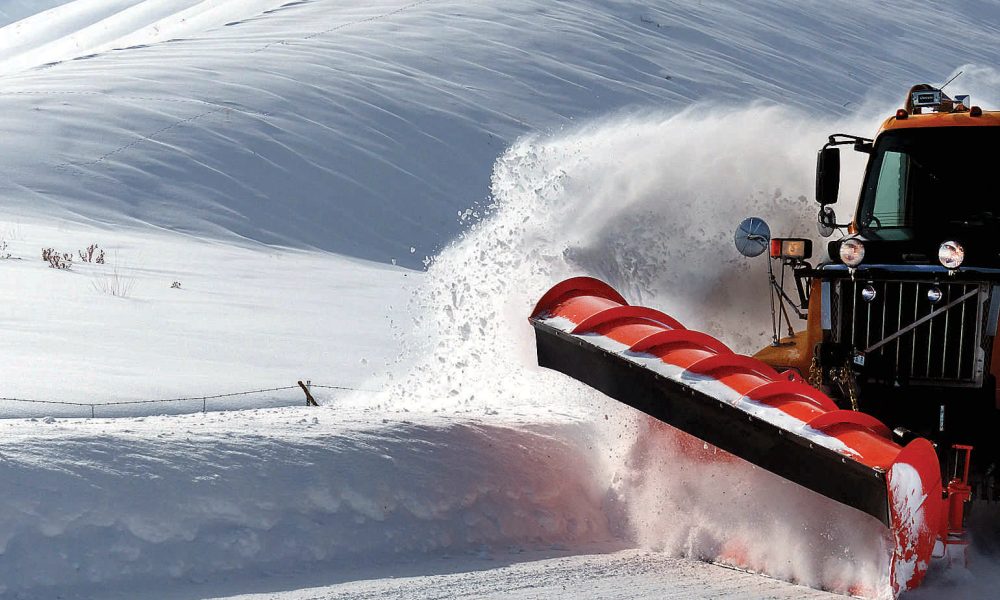
 A state Transportation Department truck makes another pass to clear U.S. 26 near Ironside on Thursday, Jan. 19, 2016. (Malheur Enterprise/Les Zaitz)
A state Transportation Department truck makes another pass to clear U.S. 26 near Ironside on Thursday, Jan. 19, 2016. (Malheur Enterprise/Les Zaitz)By Les Zaitz, John L. Braese, and Pat Caldwell
The Enterprise
The most destructive winter storm to ever hit Malheur County continued to exact a heavy toll this week, even as skies and roads cleared.
A shuttered landmark building in downtown Vale collapsed Monday just hours after public officials taped it off out of concern.
Schools, businesses and government agencies all struggled to get back to normal. Job One remained getting snow off roofs. In Nyssa, officials closed the schools early this week to finish that task. Area hotels filled with contractor crews imported to supplement local laborers wiling to work for $20 an hour cash to save buildings and homes.
They and the rest of the county seemed to catch a break as the series of storms that has pounded the county came to an end last week. The rest of this week was forecast to be cold, cold enough to keep snow and ice in place and sparing, for the moment, the threat of flooding.
But that respite comes only after one more powerful storm swept over Malheur County the afternoon of Wednesday, Jan.18. By the following morning, Ontario recorded 15 inches of snow. Other rural locales groaned under a load of up to two feet of additional snow.
Conditions for getting around were so bad, though, that Brian Wolfe, Malheur County sheriff, at one point last week urged people to just stay put for the day. It was too dangerous to travel. Even snowplows had trouble maneuvering through the sometimes blinding snowfall.
The National Weather Service reported after the last storm that snow had piled as high as four feet in areas around Ontario. The OSU’s Malheur Experiment Station north of Nyssa by late last week had 28 inches measured on the ground.
The snowfall appeared to be shattering records. The Western Regional Climate Center lists the record as 17 inches of snow in January 1950. The Experiment Station reported Monday that it logged 21.5 inches so far in January.
Authorities did everything they could to get the word out: Get that snow off the roof.
At Four Rivers Cultural Center, Executive Director Matt Stringer put out the plea for help for around-the-clock snow removal. He got 100 nibbles and only 10 of the 17 people who showed up took the $15-an-hour jobs.
Engineers had cleared the center for use two weeks ago, but the last round of snow caused damage that was so far cosmetic. Stringer said the center by last week had spent more than $20,000 clearing snow.
In some places, crews that had cleared buildings once returned to clear again. In some instances, such as commercial structures in Nyssa and Vale, it was too late.
Building after building that survived the first storms gave up under the attack of the third. Roofs caved in, walls gave out. An onion packing plant in Nyssa. The only market in Adrian. And then the home in Vale to a once popular nightspot known as the Golden Slipper.
More than 100 commercial structures and countless private buildings such as shops and carports are gone. Replacing them all will take millions – and months.
Tri-County Love Inc., an Ontario nonprofit, established a Snow Removal Fund to cover costs for getting snow off the roofs of elderly and disabled people. The fund was seeking donations to hire help because “we ran across challenges getting volunteers to assist with some homes that were obviously overloaded with snow,” said David Armstrong, executive director. He said donations can be made on its website at loveinontario.com.
Volunteers also were in short supply for Community in Action, which opened up a temporary shelter to care for homeless people. The nonprofit said up to a dozen needy individuals a night were using the shelter, but it was likely to close this week because of a shortage of volunteers. The homeless typically camp on a river island in Ontario but it has been flooded for weeks.
And while crews worked the roofs, public works crews and volunteers did all they could to open highways and city streets. In Vale, city officials decided nothing less than around-the-clock work would do.
The disruption to the county was and will remain profound. Whatever the official numbers of the snow, and whether records were shattered, didn’t much matter. For most people, the depth was just too much. Long-time residents shook their heads in disbelief, reaching back in memory and failing to find another winter so disastrous to their county.
Schools opened and closed, and the snow days are mounting. Vale imposed this Friday as a mandatory day to catch up. School districts elsewhere in the state beseeched the state for permission to shorten the school year, and such relief, if granted, could help Malheur County schools.
The cost to the economy seems incalculable. Businesses lost income because they couldn’t open or customers couldn’t reach them. The area’s agriculture industry is particularly devastated, as onion packers watched one shed after another drop, even after the snow stopped.
At the cultural center, 28 of 33 vendors said they couldn’t make it to the Ag Show set for last week, so it was postponed. The event is scheduled to open this Saturday for a two-day run.
The new worry is where all the water will go when the melting starts.
“The big danger now if we get too warm,” said Rob Hunsucker, Malheur County emergency services director.
Hunsucker said if the temperature warms but the ground remains frozen several inches down, the water will have nowhere to go.
“If it (the weather) holds we will probably be OK. That is my hope,” he said. “March could be a really different story. We could get a lot of rain and if we have all of this snow on the ground and it rains we could have some problems.”
Have a news tip? Send email to [email protected] or call 541-473-3377.




